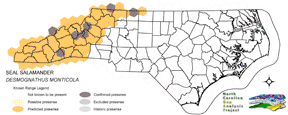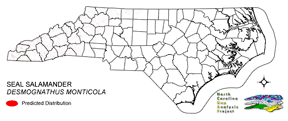
| Taxa: |
| Order: |
| Family: |
| Amphibia |
| Caudata |
| Plethodontidae |
| NatureServe Global Rank: |
| NatureServe State (NC) Rank: |
| G5 |
| S5 |
| Federal Status: |
| NC State Status: |
| --- |
| --- |


| Land Unit |
| US Fish & Wildlife Service |
| US Forest Service |
| US National Park Service |
| US Department of Defense |
| NC State Parks |
| NC University System |
| NC Wildlife Res. Com. |
| NC Forest Service |
| NC Div. of Coastal Mgmt. |
| Local Governments |
| Non-Governmental Org. |
| Other Public Lands |
| Private Lands |
| GAP Status 1-2 |
| All Protected Lands |
| Statewide |
| Hectares |
| 0.00 |
| 9,010.62 |
| 29.43 |
| 2,912.31 |
| 320.58 |
| 8.55 |
| 394.20 |
| 102.60 |
| 0.00 |
| 177.21 |
| 173.88 |
| 0.54 |
| 38,742.12 |
| 4,535.28 |
| 13,097.88 |
| 51,872.04 |
| Acres |
| 0.00 |
| 22,265.72 |
| 72.72 |
| 7,196.47 |
| 792.17 |
| 21.13 |
| 974.09 |
| 334.48 |
| 0.00 |
| 437.90 |
| 429.67 |
| 1.33 |
| 95,733.84 |
| 11,287.87 |
| 32,446.51 |
| 128,259.53 |
| % of Dist. on |
| Prot. Lands |
| 0.0 % |
| 68.8 % |
| < 0.1 % |
| 22.2 % |
| 2.4 % |
| < 0.1 % |
| 3.0 % |
| 0.8 % |
| 0.0 % |
| 1.3 % |
| 1.3 % |
| 0.0 % |
| 0.0 % |
| 34.6 % |
| ----- |
| ----- |
| % of Dist. on |
| All Lands |
| 0.0 % |
| 17.4 % |
| < 0.1 % |
| 5.6 % |
| 0.6 % |
| < 0.1 % |
| 0.8 % |
| 0.2 % |
| 0.0 % |
| 0.3 % |
| 0.3 % |
| < 0.1 % |
| 74.7 % |
| 8.7 % |
| ----- |
| ----- |
|
This salamander occurs throughout the mountains of western North Carolina and in some adjacent piedmont counties (Martof et al. 1980). It is common to abundant in its habitat. Seal salamanders are found in most forested stream situations within their range (Martof et al. 1980). Populations primarily reside in hardwood forests (Petranka 1998). NATURE SERVE GLOBAL HABITAT COMMENTS: Mountain streams, small rocky spring-fed brooks in hardwood- shaded ravines, seepeages, muddy section of streams. Hides under rocks or moss, and in burrows in mud banks. Sometimes perches on wet rocks. Eggs are laid on undersides of rocks or leaves in water or seepages; also under or in logs near water. |
| Code | Name | Description | NC Natural Heritage Program Equivalent |
| 238 | Piedmont/Mountain Submerged Aquatic Vegetation | Seasonally to permanently flooded areas with aquatic vegetation. Waterlily, pondweed, hydrilla smartweed are a few of the species that can occur. | Piedmont/Mountain Semipermanent Impoundment (in part) |
| 239 | Piedmont/Mountain Emergent Vegetation | Emergent vegetation of all wetland hydrologies. Sites would commonly support species such as tussock sedge, rushs, and cattail alliances. | Rocky Bar and Shore (in part) |
| 230 | Piedmont Mesic Forest | American Beech - Red Oak - White Oak Forests. | Mesic Mixed Hardwood |
| 384 | Piedmont/Mountain Mixed Bottomland Hardwood Forests | Includes temporarily to seasonally forests dominated by hardwood species. Hardwoods include sweetgum, red maple, sycamore which co-occur in a mosaic of bottomland and levee positions. Includes alluvial hardwood forests in the mountains. Hemlock and white pine may occur as inclusions, but are generally mapped separately. | Piedmont/Mountain Alluvial Forest, Piedmont/Mountain Levee Forest |
| 8 | Open water | Open water without aquatic vegetation. | No equivalent |
| 517 | Hemlock Floodplain Forest | Alluvial forest with hemlock and/or white pine in mountains and western piedmont. Hydrology is generally temporarily to seasonally flooded. | Canada Hemlock Forest |
| 522 | Northern Hardwoods | High Elevation forests including yellow birch, American beech, and yellow buckeye. Includes forests with Hemlock and Yellow Birch. | Northern Hardwoods Forest, Boulderfield Forest |
| 525 | Appalachian Oak Forest | A variety of oak forest types including Black, White, Scarlet Oaks in dry to mesic situations. Includes forests historically co-dominated by American Chestnut. | High Elevation Red Oak Forest, Montane White Oak Forest |
| 526 | Appalachian Cove Forest | Mixed Mesophytic forests of the mountains. Includes tuliptree, basswood, yellow buckeye and surgar maple. This class is mapped to include cove forests dominated or co-dominated by hemlock. | Rich Cove Forest, Acidic Cove Forest |
| 527 | Appalachian Hemlock | Upland hemlock forests of the moutains region. Vary from side slopes to steep slope positions. | Canada Hemlock Forest |
| 533 | Appalachian Swamp Forest | Evergreen and deciduous forests with saturated hydrologies. This class may contain a variety of trees species, including hemlock - red maple, pitch pine, and white pine forests. | Swamp Forest-Bog Complex, Southern Appalachian Bog, Southern Appalachian Fen |
|
Hairston, N. G., Sr., and R. H. Wiley. 1993. No decline in salamander (Amphibia:Caudata) populations:a twenty-year study in the southern Aplachians. Brimleyana 18:59-64.
Conant, R. and J. T. Collins. 1991. A field guide to reptiles and amphibians:eastern and central North America. Third edition. Houghton Mifflin Co., Boston, Massachusetts. 450 pp. Folkerts, G. W. 1968. The genus DESMOGNATHUS Baird (Amphibia:Plethodontidae) in Alabama. Ph.D. diss., Auburn Univ., Auburn, Alabama. 129 pp. Petranka, J. W. 1998. Salamanders of the United States and Canada. Washington DC: Smithsonian Inst. Press. Bruce, R. C. 1989. Life history of the salamander DESMOGNATHUS MONTICOLA, with a comparison of the larval periods of D. MONTICOLA and D. OCHROPHAEUS. Herpetologica 45:144-155. Bruce, R. C., and N. G. Hairston, Sr. 1990. Life-history correlates of body-size differences between two populations of the salamander, DESMOGNATHUS MONTICOLA. J. Herpetol. 24:124-134. Barbour, R. W. 1971. Amphibians and reptiles of Kentucky. Univ. Press of Kentucky, Lexington. x + 334 pp. Mount, R. H. 1975. The Reptiles and Amphibians of Alabama. Auburn University Agricultural Experiment Station, Auburn, Alabama. vii + 347 pp. Behler, J. L., and F. W. King. 1979. The Audubon Society field guide to North American reptiles and amphibians. Alfred A. Knopf, New York. 719 pp. Martof, B. S., W. M. Palmer, J. R. Bailey, and J. R. Harrison, III. 1980. Amphibians and reptiles of the Carolinas and Virginia. University of North Carolina Press, Chapel Hill, North Carolina. 264 pp. Green, N. B., and T. K. Pauley. 1987. Amphibians and reptiles in West Virginia. University of Pittsburg Press, Pittsburg, Pennsylvania. xi + 241 pp. Collins, J. T. 1990. Standard common and current scientific names for North American amphibians and reptiles. SSAR Herpetol. Circular No. 19. 41 pp. |
For more information please contact them at:
NC-GAP Analysis Project
Dept. of Zoology, NCSU
Campus Box 7617
Raleigh, NC 27695-7617
(919) 513-2853
www.basic.ncsu.edu/ncgap